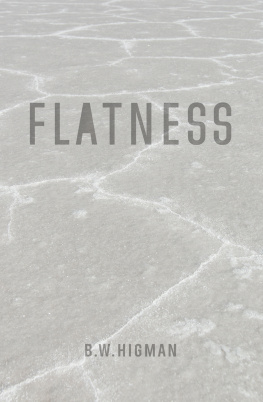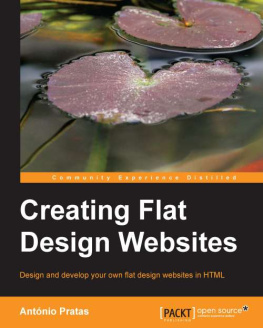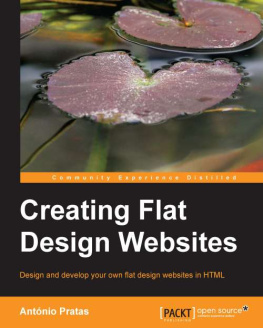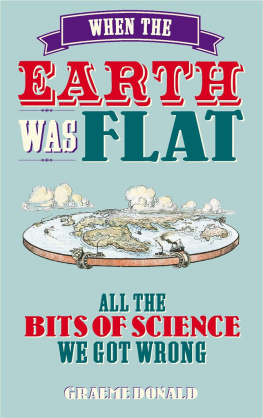FLATNESS

FLATNESS
B. W. HIGMAN
REAKTION BOOKS
Published by Reaktion Books Ltd
Unit 32, Waterside
4448 Wharf Road
London N1 7UX, UK
www.reaktionbooks.co.uk
First published 2017
Copyright B. W. Higman 2017
All rights reserved
No part of this publication may be reproduced, stored in a retrieval system, or transmitted, in any form or by any means, electronic, mechanical, photocopying, recording or otherwise, without the prior permission of the publishers
Page references in the Photo Acknowledgements and
Index match the printed edition of this book.
Printed and bound in China by 1010 Printing International Ltd
A catalogue record for this book is available from the British Library
eISBN: 9781780237763
CONTENTS

Frank den Oudsten, interior of the Schrder House, Utrecht, by Gerrit Rietveld, 1924.
ONE
CONCEPTUALIZING FLATNESS
Planar surfaces and variants of planar order are so pervasive and so encompassing, so fundamental to our behaviour and thought, that it is easy to think of them as natural.
David Summers, 2003
Wherever you find yourself reading these words, you very likely inhabit a space dominated by flat surfaces. This is a condition of the modern world. The words themselves are formed by flat characters on flat paper or on a flat-panel display. The room you occupy is almost certainly a box defined by its flat floor, walls and ceiling, perhaps furnished with a flatweave rug or carpet, tables, bookshelves and cabinets, and decorated with pictures and posters or maps, all of these things dependent on external and internal flatness for their efficiency and functionality. Perhaps you are lying down, stretched out in the horizontal, the orientation adopted for about a third of your life.
When you stand to leave the room, you assume there is an even surface beneath your feet including steps and stairs or watch warily for hazards like sudden drops or random toys. Walking confidently, you scan the flat screen of your phone or watch. If you leave your home or office to ride or drive, you move swiftly and smoothly along flattened roads, rails or pathways, perhaps travelling to play sport on a level playing field, and parking in a level car park. For many of us, a wide variety of daily activities are performed on a flat screen: everything from sending and receiving text messages to paying bills, reading books, checking the news and weather, watching television and viewing videos. In the United States, adults spend about ten hours each day staring at such screens. We can fly from Madrid to Mexico City, sitting in a chair, our feet firmly planted on a flat floor, watching movies or playing games on a flat screen, and finally landing on a flattened runway, every surface on which we step unnatural.
All of these surfaces are crafted or engineered, placing manufactured or artificial flatness at the centre of the everyday experience of modern life. However, as the art historian David Summers argues, we hardly notice this pervasive planarity, seeing it as inevitable or almost natural. Flatness is fundamental to the Anthropocene, the recently recognized era in which human beings have taken a leading role in the shaping of the Earth. Our experience stands in strong contrast to the structure of the natural world and the spatiality of the greater part of human history. Today, for instance, more than 50 million kilometres of roads, with their annexed driveways and vast car parks, dominate the daily movement of most of the worlds people; and 1 million kilometres of railways link levelled croplands with architecturally planar cities. In the 1960s and 70s, before the advent of the multi-storey car park (parking garage), more than two-thirds of the land space in downtown districts of major U.S. cities was taken up in streets and car parks. All of these locally levelled landscapes are the product of forest-clearing and earth-moving projects designed to carve out and build up flat surfaces. The Earth has been given a new skin, notably concrete and asphalt, designed both to obliterate what beauty had existed previously and to inhibit natural processes of change to install flatness as a permanent condition.
We tend not to notice that more than two-thirds of the planet remains covered by water, finding its own natural level. Even in the era of the Anthropocene when hubris crowns humans as the great movers and shapers we have done nothing to alter the local flatness or global curvature of the ocean surface, however much or little we have raised sea levels through our contribution to global warming. Thus, although the physical transformation represented by the modern flattening of the world is profound, it must be qualified and limited to terra firma. Indeed, it can be argued that the many advantages of the flatness of the ocean surface have been applied to activities on land, most obviously lower transportation costs and increased speed and comfort.

Escalators enable movement from one flat surface to another, along a slope, while standing vertical on a flat platform: in the Berlin Hauptbahnhof, 2011.
Variations in scale and perspective bring ambiguity to our perception of flatness. At sea, a ship sits on the flatness of the surrounding ocean, a perception only weakly belied by the curvature of the horizon; in contrast, viewed from a space station, Earths curvature erases all notions of flatness. In the same way, we would experience the surface quite differently if we had the stature of an ant or, perhaps, a giraffe. Because things look different from different perspectives and at different scales, it comes as no surprise that when the spatial concept of flatness is allowed to take on metaphorical, philosophical and spiritual meanings, it shares the ambiguity found in perceptions of the material world.
Flatness is a quality that is highly desired yet frequently disparaged. The tension lies in the word itself. On the one hand, flatness indicates smoothness, evenness, levelness and predictability, all useful characteristics that facilitate movement and activity, things that contribute to social and economic efficiency. At the same time, it identifies corollaries such as monotony, homogeneity, sameness, emptiness, absence, lack, insipidity, dullness, deficiency, tedium, boredom and even deadness. It describes the degradation of social and individual experience under modernism, the levelling associated with the commodification and commercialization of cultural life.
Flat lands are often dismissed as featureless, boring, uninteresting and depressing because they seem to represent the antithesis of the scenery that modern humans appreciate, lacking natural beauty and majesty. On the other hand, human beings fear change and desire stability. No one wants a bumpy ride. So flat pathways are good to walk or drive on, level playing fields allow fair contests in sport, and flat sites are good for building secure and stable structures. It is distressing when these are flattened by storms or warfare.
To feel flat is to feel down, but to be level-headed and evenhanded is to behave in a fair and consistent manner. In fiction, flat characters keep popping up in the same guise, dependable and predictable, never developing complex profiles. Flat affect exhibits a lack of emotion or perhaps its suppression; it is an attitude attributed to Barack Obama, for example, by political opponents who believe that anger and fury are more appropriate responses to certain situations. Societies with a relatively flat distribution of wealth and income are seen as egalitarian, flat societies sometimes based on a flat tax but a flat economy is undesirable. Being flat broke is a bad financial situation. Flat beer and flat champagne are no good. A flat note is not music to the ears. It is exhausting to go flat out, but to fall flat is to fail.















